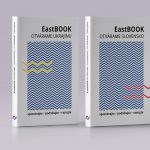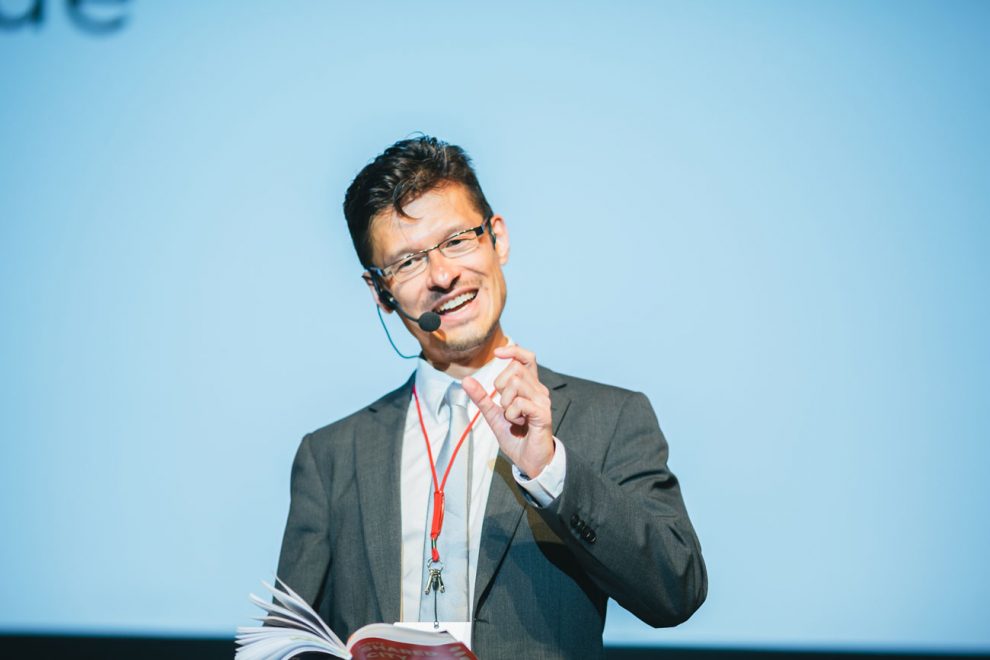Osamu Okamura is a Czech architect of Japanese origin. Osamu was born in Tokyo and got his degree in architecture in the Czech Republic. Today Mr Okamura is working as an architect and organizer of reSITE that is a prestigious international festival of architecture in Prague annually visited by famous architects from all over the world searching for the exchange of best practices. Osamu is professionally engaged in urban design and quality of life in cities. Osamu loves Prague, has a bicycle and annual bus pass and desperately hates cars… A couple of years ago Osamu discovered Uzhgorod. Surprisingly, the Czech architect sees things that we haven’t noticed for a long time. Osamu and I discussed the way any modern city must look like and cast some light on what actually urbanization is and his vision of Uzhgorod.
— How did you get to Uzhgorod for the first time?
— Being an architect means traveling a lot. I have long wished to get to Ukraine. I decided to come to Uzhgorod last summer during my vocation. I lived in Zakarpatye hotel. Someone can find it strange but I must admit it’s a very interesting modernist building, though it’s not in its best shape. But from the professional point of view it’s a very qualitative piece of architecture with a good concept.
— What were your first impressions of the city?
— I was shocked that the city is so close to the border. I had seen that on the map before but when I came to the city I had completely different emotions. It’s a bit strange because when you come to another country the first thing you might normally see is nature and fields and in this case you get directly to the streets of the city. Well, it’s the accessibility of the city through the Victory prospect that is one of the finest tourist attractions. This street has its own flavour and it tells you quite a lot about the city. I would say this prospect is quite pompous. The architects of that epoch seemed to have pursued the goal to show the city as young and ambitious. This kind of architecture was quite progressive at the time and it also solved housing problems of the citizens of the city. But it is the bus station and the space around it that made a bad impression on me. Real chaos reigns there – the styles are mixed and there are lots of strange boxes, booths and shops everywhere…In other words, thee is an evident lack of urban design and planning. As a rule, when I visit a new city I visit the city center as well as the city’s periphery in that I do believe the truth lies there.
— Is there a big difference between the city center and the periphery?
— This difference is huge! When I think of Galagov, the administrative district of Uzhgorod built by the Czechs I usually feel like I’m somewhere in Prague. This is a well-designed and thought-out district. Even trees that create shadows for people on hot summer days are taken into consideration. But there is a huge gap between this district and the bus station or residential districts of Uzhgorod. It seems like these sites are parts of different cities that are living their own life.
— Can you still feel the Czech influence on the architecture in Uzhgorod?
— Yes. But it’s rather Central European influence. Even the stone-block pavement in Galagov is the same as in Prague! It has the same size! And it was paved just like in the capital of the Czech Republic. It really surprised me.
What else surprised you?
On my first day in Uzhgorod I went for a walk in the city. It was really dark. The illumination of the city was really poor. I must admit that my impression of the city was quite bad at that moment. I even began to think that the city didn’t seem to have any promising future. But I suddenly saw some people watching a film using a projector apparatus that projected an image onto a building. But what was my astonishment when it appeared to be a documentary film about bicycle lanes of the city. Having watched the movie the people started discussing this topic. I joined that discussion. They turned out to be a group of young activists who cared about the city. I have to say I was really impressed. That’s how my relationship with Uzhgorod began. This year the city’s activists have organized a conference on urban design in Uzhgorod. And I’m happy to be here as a lecturer.
— What kind of character does the city have?
—A very contrastive character. It’s a very dynamic city that is developing fast. Unfortunately, it’s a chaotic process. But at the same time the city is close to nature. It is the differences in urban design of different parts of the city that may strike your eye. I think people in Uzhgorod strive to preserve the old city and, in my opinion, it’s very important, but they should think of the periphery as well. This is where people live and thus this area should be taken care of.
I am talking to Osamu in one of the fashionable cafes that is almost on the rooftop and overlooks a beautiful view of the hills of Uzhgorod. Osamu likes the view of the city but then he immediately notices some elements that “stick out” and strike a discordant note.
— Look at this building. (Osamu is pointing at a private building on the hill of the city. By the way, the building belongs to one of the city deputies). It’s very difficult to get to that building. In addition, if the city afforded this kind of private sector, it has no other option but to create the necessary infrastructure for it. Who will pay for the roads to this sector? They will be paid by ordinary people. Besides, the city will have to take on responsibility to provide electricity and drainage to this elite sector. The maintenance of the whole infrastructure will cost a lot of money in the future. It’s an example of a very poor urban design and planning. In fact, it’s just stealing money from the city budget.
— Stealing?
— Long-term stealing..
— Why do you hate cars so much?
— Cars kill urbanization as a concept. It’s not only in Uzhgorod, but around the whole world as well. There is no such inspiration from automobile transport that used to reign back in 60-70. Our massive use of automobiles caused a real urban catastrophe – in some American cities roads occupy 80% of their space.
— What is the situation with automobiles in Tokyo?
It’s opposite to the one in the USA. The land is very expensive in Tokyo. You won’t be allowed to park your car outside. Furthermore, you won’t be able to buy a car until you provide some documents that you have rented a parking lot for at least one year. Buying a car is not a problem in Japan, but the problem is to find a parking place. That’s why despite a great number of citizens, Tokyo is a very compact city – you can get to any part of the city on foot. Besides, Tokyo has one of the best public transport systems in the world. No one hesitates to get to work by metro, bus or bicycle and it’s believed to be normal.
— What is the situation in the Czech Republic?
— The situation is bad. In early nineties the citizens of Prague used to build their homes outside the city. The distance from their homes to their offices can well exceed 20 km. Now you can see thousands of city dwellers being stuck in traffic jams and having breakfast in their cars. It’s a paradox: you have a big country house with your own yard, but you don’t have a freedom of movement. People depend on their cars. People who suffer most are teenagers, who want to communicate with their friends, and elderly people that find it really difficult to get to the city. Now in Prague people tend to return to the city.
— How do you get to work?
— Well, I usually go there by bus or bicycle. I don’t have a car and I’ve never had. I’m a big fan of public transport. It’s easy to calculate the number of people that can fit in a bus and how many of them can be seated in one car. There can be a lot of people in a bus, while there is usually only one person in a car. Busses should have priority in all respects. When cars are in a traffic jam, busses must go. City authorities must do everything so that pedestrians, cyclists and public transport could have an advantage in all respects. Copenhagen has an interesting experience in urban design and planning. A couple of years ago the city authorities decided to increases the number of pedestrians in the city by 10%. It was very important for the city, because this increase meant more profit for small shops. And that automatically meant an increase in living standards. It also stimulated communication and exchange of thoughts and ideas between people. It’s a very long chain of interrelated things that people and their city can benefit from. In fact, it was a very important and ambitious goal. Trust me, it’s not that easy to increase the number of pedestrians. But Copenhagen achieved that.
— How did they manage to do that?
— Some serious research was conducted. They scientifically proved why the width of the pavement on different sides must be different. Experts in urban planning found out whether people walked more on the Southern or Northern side. It turned out that Southern pavements must have been wider, because in such a Northern country as Denmark people like walking in the sun, that is the Southern side of the street. It may seem strange, but the profit of shops greatly depended on that decision and in the end it made all the difference. After such a delicate planning and development of the urban design the atmosphere in the city changed dramatically: it became better, more comfortable and active.
— How do you feel about the number of cars in Uzhgorod?
— Everything is completely different here. This city belongs to cars. There are too many of them, especially in the city center that is supposed to be pedestrian. It just seems they have to survive here. A parking area in the city center is a bit over the top! I will also mention Japan as an example – no one can afford it there. In Europe people tend to lose what they have. In the US the situation is even worse. Because of the lack of land Japanese people began to think much of every centimeter of space and make sure it yields the best results. In Uzhgorod cars have advantages over pedestrians in all respects.
— Can ordinary people change their city or at least influence its development?
— Of course, they can! Every person can change their city by making their choice every morning and thinking of how they want to get to their work, school or somewhere else. If this person decides to go to work on foot, it will change the city and their perception of things as well, trust me.
— But how?
— This person will perceive the city in a completely different way. Besides that, people will start thinking of what city they actually want to live in, how far their apartment must be from their office, how pavements in their city should look like. If you go for a car in the morning, this decision will also influence the city. Your perception of space will be different as well. When we go by car we don’t normally care much about the way the pavement looks like and how many benches our city has. That’s why I always say that planning of the city and its design don’t only depend on architects but are really dependent on ordinary people as well.
— What is your favorite city?
— It’s hard to say… Maybe, you should ask about my favorite place in a city. For instance, in Prague I like the seafront of Vltava. Here you can feel like you’re not in the city at all. I would say, any city is not just its streets and buildings. Any city is all about its people. During different periods of my life I want to be with different people. Fortunately, they live in different cities.
Source: Uzhgorod.in









Add Comment